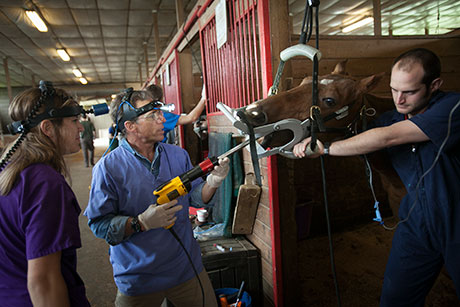Students learn straight from the horse's mouth
By Krishna Ramanujan


With one hand grasping a horse’s big tongue, fourth-year veterinary student Catarina Ruksznis turned on the PowerFloat. Similar in appearance to a long-barreled handgun, the PowerFloat is a power drill fitted with a barrel and a tungsten carbide grinding wheel. Ruksznis, participating in the Equine Specialty Rotation at the College of Veterinary Medicine, began filing down sharp enamel points on the edge of the teeth.
Students in the Equine Specialty Rotation spent the week of May 5 honing their dentistry skills at the Cornell John T. Oxley Equestrian Center on Pine Tree Road as part of the course. Earlier in the semester, they primarily participated in clinical rotations working on animals admitted to Cornell’s Animal Hospital for a wide variety of medical conditions.
“We want to teach students the basic skills that are expected of them when they enter equine practice,” said Dr. Gillian Perkins, course leader of the Equine Specialty Rotation and a senior lecturer of large animal medicine in the college.
The dental procedure, known as “floating,” is necessary periodically because horses’ upper jaw and teeth are wider than their lower ones. Due to the way that the upper and lower teeth align, sharp edges tend to develop on the inner side of the lower teeth and on the outer side of the upper teeth where no grinding occurs. Horse teeth are long when they are young but wear down over time, similar to lead in a mechanical pencil, Perkins said. Eventually, if the horse lives long enough, the teeth can be worn down completely, and then special feed is required.
For the dental procedures, horses are sedated standing up and fitted with a speculum that holds their mouths open. Students also use an arthroscope to visually inspect the teeth and take photographs and videos of the horses’ mouths for analysis.
The dental section of the equine rotation was assisted by Dr. Robert Baratt from Connecticut and Dr. Edward Earley from Pennsylvania, both practicing veterinarians and equine dental experts. The rotation trains the students to be able to perform these techniques on the first day of a new job, Perkins said.
All the horses that the students worked on are Cornell-owned, and the rotation offers a necessary service that would otherwise be costly. “It’s a win-win,” Perkins said. “The students get experience, and the Cornell animals get looked after.”
Every veterinary student participates in 12 core clinical rotations giving them a well-rounded education in both small and large animal veterinary specialties. In addition, students select one of six Clinical Pathways, comprising eight additional rotations, of which the Equine Specialty Rotation is one. This allows students to tailor a component of their clinical training to meet their interests and professional goals.
Media Contact
Get Cornell news delivered right to your inbox.
Subscribe